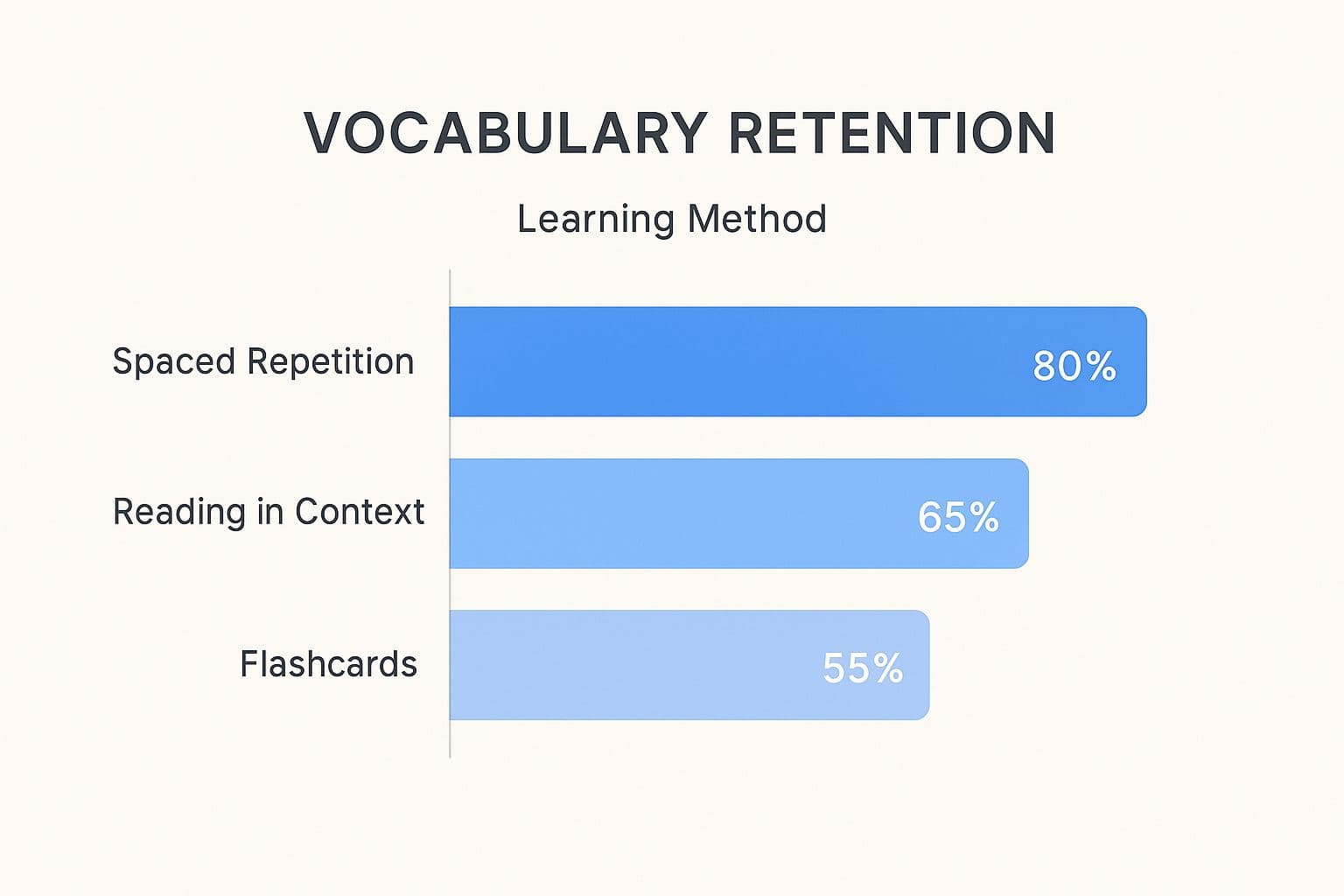How to Improve Writing With AI Assistants
Learn how to improve writing with powerful AI assistants. Get practical, real-world tips for using AI to brainstorm, draft, and refine your text like a pro.

Learning how to improve writing just got a whole lot more interesting, thanks to a powerful new tool: AI. The trick is to stop thinking of it as a robotic shortcut and start seeing it as a seriously smart assistant. It’s here to handle the tedious stuff, freeing you up to do the real creative heavy lifting. It's about working smarter, not harder, to get your message across clearly and effectively.
Your New AI Writing Partner

If you're serious about elevating your writing, it's time to reframe your view of artificial intelligence. Don't think of AI as something that writes for you. Instead, look at it as your new writing partner—a collaborator that absolutely crushes the tasks that usually bog you down in your daily life.
This new dynamic is all about shifting your role from writer to director. You're no longer just the writer; you're the editor-in-chief, and you've got a super-fast AI assistant on your team. You bring the strategy, the insight, and the final polish. The AI handles the initial grunt work, making you more productive with every task.
Supercharge Your Daily Writing Tasks
Think about that important email you need to send. Instead of staring at a blank screen, you can toss a few bullet points to your AI partner and ask it to whip up a first draft. Just like that, you have a solid foundation to edit and personalize, which can literally cut your writing time in half and ensure you get your point across effectively.
This same productive approach works for almost any daily text-based task:
- Brainstorming: Give the AI a topic and ask for ten different blog post angles or a handful of catchy headlines for a presentation.
- Outlining: Hand over a core idea and have it map out a logical structure with main sections and sub-points for a report.
- Research: Need a quick summary of a dense article or some key stats for your work? Just ask.
This hybrid approach makes the whole writing process faster and way more efficient. It’s no surprise that AI writing assistants are changing the game for individuals and companies everywhere. A recent analysis found that a staggering 85% of AI users in 2023 relied on these tools primarily for content creation. This really highlights how central AI has become to improving writing globally. You can explore more data on AI's role in writing to see the full picture.
Key Takeaway: The goal isn't to outsource your thinking. It's to delegate the mechanical parts of writing so you can pour your brainpower into what really matters—creativity, strategy, and adding that unique human touch nobody else can. This is how you gain a real, meaningful benefit from AI.
From Writer to Editor-in-Chief
Getting this mindset right is the first, most important step. When you treat AI like a junior partner, you stay in the driver's seat. You’re the one who guides the tone, fact-checks the details, and makes sure the final message actually connects with your audience. The AI gives you the raw materials, but you’re the artisan who shapes it into a polished, finished piece.
Quick-Start Guide to Improving Writing with AI
To get you started, here's a quick rundown of the easiest ways to bring AI into your daily workflow for some immediate productivity wins.
| AI Application | How It Boosts Your Productivity | Best For |
|---|---|---|
| Drafting Emails & Messages | Generates a first draft from a few bullet points. | Overcoming writer's block and speeding up daily communications. |
| Brainstorming Ideas | Provides lists of headlines, topics, or different angles on a subject. | When you're stuck for ideas or need fresh perspectives quickly. |
| Creating Outlines | Structures your thoughts into a logical flow with headings and sub-points. | Organizing long-form content like articles, reports, or presentations. |
| Summarizing Information | Condenses long articles or research into key takeaways. | Quickly understanding complex topics without a deep-dive read. |
This table should give you a clear path to getting started. This guide will walk you through exactly how to make this partnership flourish. We'll start with these quick, practical wins you can use today to see an immediate boost in your daily writing, setting you on a path to becoming a more productive—and surprisingly more creative—writer.
2. Conquer the Blank Page with AI Brainstorming

We’ve all been there. Staring at that blinking cursor on a blank page, your mind just as empty. It’s the classic writer’s nightmare, and it can bring your productivity to a screeching halt. This is precisely where an AI assistant becomes your secret weapon for daily text tasks. Think of it as a brainstorming partner that can help you dig up fresh ideas and lay down a solid foundation for your writing.
The trick is to go beyond simple commands and actually talk to your AI. Instead of just asking for "blog post ideas," you need to get specific and treat it like a creative collaborator. This is how you transform that empty document into a detailed roadmap, saving yourself a ton of frustration and boosting your productivity.
Let’s Get Chatty: Using Conversational Prompts
Your first prompt is just the opening line of a conversation. Your job is to steer the AI toward the unique angles and structures you’re after. The real magic isn’t in the first ask; it's in the follow-up questions where you provide context and refine the results. This back-and-forth approach is a game-changer for getting things done efficiently.
Let’s say you’re tasked with writing an email to your team about a new productivity initiative. Here’s how that conversation might play out:
- You (the initial prompt): "I need to write an email to my team about a new 'no-meeting Wednesday' policy. The tone should be positive and focus on the benefits. Can you brainstorm three subject lines that sound exciting, not demanding?"
- You (the follow-up): "Great, I like 'Reclaim Your Wednesdays: Introducing Focus Time.' Now, draft a short, friendly email using that subject line. Explain the 'why' behind the policy—more deep work time—and list the basic rules."
- You (the final step): "That’s a good start. Now, make the intro paragraph more punchy and add a call to action at the end asking them to share their feedback in our team channel by Friday."
In just a few minutes, you’ve gone from a vague task to a complete, ready-to-send email. This isn't about having the AI write for you. It's about using its processing power to organize your thoughts and leap over that initial hurdle.
My Pro Tip: The best way to use AI for daily tasks is to treat it like a junior creative on your team. Give it a role, provide clear context, and then guide it through a few rounds of feedback to build the exact content you need.
From Jumbled Ideas to a Solid Outline
Once you’ve got a core idea, it’s time to build a strong outline. I can’t stress this enough: a good outline is the skeleton of any great piece of writing. It makes sure your arguments flow logically and that you hit every crucial point. Mastering this is fundamental for anyone looking to be more productive with text.
Your AI can do the heavy lifting of creating this structure. All you have to do is feed it the core topic and the sections you want to include. For example, maybe you're drafting a project proposal. You could prompt it like this:
"Create an outline for a project proposal about launching a new company newsletter. The outline should include a background section, project goals (e.g., increase employee engagement by 15%), a proposed content plan, required resources, a timeline, and key metrics for success."
By giving the AI a clear task with all the necessary parts, you get back a step-by-step guide. It turns the intimidating job of writing from scratch into a much simpler process of just filling in the blanks with your own expertise and personality.
Let AI Help You Lay the Groundwork

Alright, you've got a solid outline. Now for the part where so many of us get stuck: the first draft. Staring at that blank page can be intimidating, but what if you didn't have to start from scratch? This is where your AI partner comes in, not to write for you, but to give you a lump of clay you can start molding. This is a core productivity hack.
Think of it as micro-drafting. Instead of asking an AI to write a whole article (which usually ends up generic and bland), feed it your outline one section at a time. This keeps you in the driver's seat. You provide the instructions, the key points, and the desired tone for each small chunk, making the AI's output much more focused and useful for your daily work.
This is all about collaboration. You're the director, and the AI is your very fast, slightly clueless intern. It’s a core skill to master if you want to be more productive and stay ahead of the curve.
Your New Favorite Research Assistant
Let's be honest, one of the biggest drains on your daily productivity is research. Digging for stats, summarizing dense reports—it can take hours. Why not outsource that?
Instead of opening a dozen browser tabs, just ask your AI. Something like, "What are three key strategies for improving customer retention in e-commerce?" or "Can you summarize the main points from this attached meeting transcript?" The AI can pull that information in seconds, freeing you up to do what you do best: applying those insights to your work.
My Two Cents: The real magic of AI in drafting isn't just about spitting out words. It's about how quickly it can gather and condense information. Your writing becomes faster, sure, but it also becomes more informed and data-rich with a fraction of the effort, delivering meaningful benefits to your work quality.
This hybrid model—AI for the grunt work, human for the soul—is quickly becoming the gold standard for productivity. The AI handles the data, but you're the one adding the critical analysis, personal anecdotes, and unique voice that make the content worth reading.
Polishing and Perfecting on the Fly
Ever write a sentence that just feels… off? The old way was to delete it and agonize over a new version. The new, more productive way is to let your AI take a crack at it.
Just highlight the text and ask for what you need. "Rewrite this to sound more confident." Or, my personal favorite, "Give me three different ways to say this, but make them punchier." It’s an incredible way to break through a mini writer's block without losing your flow.
Here are a few ways I use this in my daily life:
- For Clarity: "Simplify this technical sentence for a non-expert audience."
- For Tone: "Make this paragraph sound more empathetic for a customer service reply."
- For Engagement: "Turn these bullet points into a compelling paragraph for a project update."
Getting great results from your AI really comes down to how well you can instruct it. Learning the best practices for prompt engineering is a game-changer and will make your AI a true collaborator instead of just a content mill.
Giving Your AI Draft a Human Heartbeat
Alright, let's be real. An AI draft is an incredible head start, but that's all it is—a start. If you really want to learn how to improve writing with AI, the magic happens when you roll up your sleeves and add your own unique, human touch. This is where you gain the most meaningful benefit: taking functional but soulless text and turning it into something that actually connects with people. The final piece needs your stories, your opinions, and your expert eye.
I like to think of the first draft as a rough sketch. The AI has drawn the basic outline, but you're the artist who adds the color, the shading, and the details that make it come alive. That means it's time to get your hands dirty and start editing.
Sniffing Out the AI "Tells"
AI writing has a few giveaways that just scream "a robot wrote this!" Once you know what to look for, you can spot and fix them in minutes. Keep an eye out for overly formal language, perfectly uniform sentence structures, and a complete lack of personality. AI tends to play it safe, avoiding any real opinions or unique takes.
Your first read-through should be a search-and-destroy mission for these robotic traces. Just ask yourself, "Would a real person actually talk like this in an email or a message?" If the answer is a hard no, it's time to rewrite that sentence in your own voice.
My Two Cents: Your goal here isn't just to fix typos. It's to inject authenticity. An AI can't tell that funny story about a project that went sideways or share a genuine "aha!" moment. Only you can do that. Sprinkling in your own experiences is the quickest way to make the content undeniably yours.
My Go-To Human Editing Checklist
Once you've flagged the robotic bits, it’s time to do a proper, line-by-line edit. Don't just give it a quick once-over. Go in with a plan. Here's the checklist I personally use for any AI-assisted text:
- Fact-Check Everything. Seriously. AI is notorious for "hallucinating" facts or pulling up stats from 2015. Never, ever trust an AI-generated fact, statistic, or quote without checking it yourself. Cross-reference every claim with a couple of reliable, up-to-date sources.
- Add Your Voice. Read the whole thing out loud. Does it sound like you? If it sounds like a stiff corporate memo, rework those sentences. Use the words you’d actually use in a conversation. Drop in a personal story or an example from a client you worked with.
- Kill Vague Language. AI loves wimpy phrases like "it is important to" or "this can be beneficial." Cut them. Replace them with strong, direct statements. Instead of saying something is "good for business," get specific. Tell me how it boosts revenue by 15% or cuts down on meeting time.
This editing process is where you create all the value. It’s what separates bland, machine-made content from the kind of high-quality writing that makes people trust you and want to hear more from you.
Make the AI Your Editing Assistant
Now for a pro move. Don't just take the AI's first draft and run. Flip the script and make the AI your personal editing assistant. This is a brilliant way to be more productive while staying completely in the driver's seat.
Take a paragraph you've already rewritten and feed it back to the AI with specific commands. I do this all the time with prompts like:
- "Give me three stronger verbs for this sentence."
- "Make this paragraph sound more direct and punchy."
- "Can you simplify this explanation for a total beginner?"
- "Check this for clarity. Is there a better way to phrase this?"
By turning the tables, you stay in the editor's chair, using the AI's processing power to sharpen your own ideas. This back-and-forth makes sure the final article isn't just clean and polished—it's 100% you.
Finding the Right AI Writing Tool for You
Let's be honest, the market for AI writing tools is a jungle. There are a million options out there, all claiming to be the best. It’s easy to get overwhelmed. The real secret to being more productive with AI is to cut through the noise and figure out what you actually need to make your daily writing better and your life easier.
Instead of just throwing a list of tools at you, I want to give you a way to think about this. The perfect tool for a student trying to nail a term paper is totally different from what a marketer needs to churn out blog posts or a professional needs to polish up client emails. It all comes down to your specific, day-to-day tasks.
The goal isn't just about cool features; it's about finding an AI partner that slides right into your existing workflow without causing a headache, providing a meaningful benefit.
What Kind of AI User Are You?
Let’s figure out where you fit in. There’s no point in paying for a massive, all-in-one platform if a simple, powerful proofreader is all you really need for your daily tasks.
- Grammar and Style Checkers: Think of these as your first line of defense. They do way more than your basic spell check, catching clunky sentences, fixing awkward phrasing, and helping you nail the right tone. They're perfect for pretty much everyone who writes anything.
- AI Writing Assistants: These are more like a creative partner. They're brilliant for breaking through writer's block by helping you brainstorm ideas, generate outlines, or even draft entire sections based on your prompts. If you're a content creator or marketer, these are a game-changer.
- All-in-One Suites: These are the big guns. They bundle everything together—drafting, research, editing, SEO analysis, you name it. They’re best suited for professionals and teams who are managing a high volume of content and need one central hub to keep everything organized.
The market for this kind of software has exploded. To really get a sense of how you can integrate these for maximum productivity, you can explore this quick guide to mastering AI workflow automation tools.
A tool is only as good as the problem it solves. The whole point is to find something that removes friction from your writing process, not to add another complicated piece of software you have to learn.
Comparing Popular AI Writing Tools
To give you a clearer picture, I've put together a quick comparison table. This isn't an exhaustive list, but it shows how different types of tools are designed for different kinds of writers and tasks.
| Tool Type | Primary Use | Ideal For | Example Tools |
|---|---|---|---|
| Grammar & Style | Polishing grammar, tone, and clarity. | Students, professionals, everyday writers. | Grammarly, ProWritingAid |
| AI Assistant | Brainstorming, outlining, and drafting. | Marketers, bloggers, copywriters. | Jasper, Copy.ai |
| All-in-One Suite | End-to-end content creation. | Content teams, agencies, power users. | Surfer SEO, Frase |
Finding the right fit in this table can point you toward a tool that genuinely helps you improve your daily productivity, rather than just becoming another subscription you forget about.
This image really drives home how different learning methods—many of which can be built into AI tools—affect how well we remember things.

As you can see, active learning techniques like spaced repetition are far more effective for building your vocabulary and skills. When you're looking at different AI tools, consider picking one that supports these proven methods. You won't just be writing better in the short term; you'll actually be growing as a writer for the long haul, gaining a lasting benefit.
Your Questions About AI Writing, Answered
Jumping into AI writing tools is exciting, but let's be real—it also brings up a ton of questions. If you're wondering about the ethics, how hard it is to learn, or if it will actually make you a better writer and more productive, you're not alone. Let's tackle some of those common concerns head-on.
This isn't about just hitting a button and letting a robot take over. It’s about learning to use AI as a smart collaborator. When you get the hang of it, you’ll find it’s an incredible way to sharpen your skills and get more done in your daily life.
Is Using AI to Write Cheating or Plagiarism?
This is the big one, right? Here’s the simple truth: it’s not cheating when you use AI to support your own ideas and thinking. The problem comes in when you try to pass off AI-generated text as your own without adding your unique perspective or making significant edits. That’s when it crosses the line into plagiarism.
I like to think of it like using a spell-checker or a thesaurus. Those tools help you refine your work, but they don't do the thinking for you. An AI can help you brainstorm, clean up your grammar, or structure an outline, but the final piece—the core message and the voice—has to be yours.
Key Takeaway: You get into trouble when you completely outsource your thinking. As long as you’re the one fact-checking, injecting your expertise, and making sure the writing sounds like you, you’re just using a powerful tool to work smarter and be more productive.
Can AI Actually Make Me a Better Writer Over Time?
Absolutely, and this is probably the most underrated benefit of using AI. Think of it as your own personal writing coach, available 24/7. When you ask an AI to rephrase an awkward sentence or give you a few stronger verb options, you're not just fixing one little problem. You're learning in real time.
By looking at the suggestions it gives, you start to see patterns in your own writing—the crutch words you lean on, the convoluted sentences you tend to write. Over time, you internalize these lessons and naturally start writing with more clarity and impact. To really unlock this, learning how to master AI prompting is crucial for getting the best feedback.
What’s the Best AI Tool for a Total Beginner?
If you're just starting out, my advice is to pick a tool that slides right into your existing routine without a fuss. The last thing you want is a complicated new app to learn. Look for AI features that are already built into the programs you use every day, like Notion or Google Docs.
Another great place to start is with a user-friendly grammar and style checker. These tools are fantastic for helping with tone, clarity, and correctness, which is a perfect way to build up your confidence and get comfortable with AI assistance for everyday text tasks.
Ready to stop switching tabs and start applying AI seamlessly across all your apps? TypeBoost is a lightweight macOS app that lets you use your own custom prompts on any selected text or voice input, instantly. Fix grammar, rewrite content, or turn spoken ideas into polished text without ever leaving your current window. Give TypeBoost a try and see how much faster you can write.